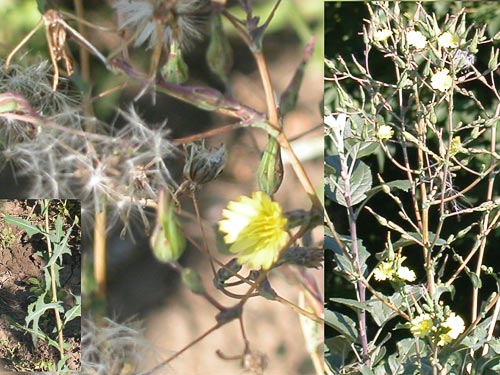Weeds
Lactuca serriola L. (=L. scariola L.) - Prickly Lettuce.
Systematic position.
Family Asteraceae (Compositae), genus Lactuca L.Biological group.
Winter annual or biannual weed.Morphology and biology.
Root stalky; the root system is well developed. The stalk straight, covered with setae below, 50-140 cm in height. Leaves alternate, emarginate-pinnatipartite (upper leaves entire-kind), with prickly denticles and rigid setae. Stem leaves sessile, cordate or sagittate at base; their leaf blades are steeply located. Inflorescence is pyramidal panicle consisting of small calathidia of 2-4 mm in diameter. Calathidium contains 8 to 16 pale yellow ligulate flowers. Involucre lengthened, three and more times longer than wide. Receptacle bare. Fruits are gray or brownish longitudinal-costate hemicarps with rostellum and pappus. Hemicarps oblong or obovoid, about 3.5 mm in length and to 1.3 mm in width. Pappus consists of simple white soft hairs with indistinguishable corona. Plants contain white lacteal juice. Blossoming from July to late autumn, fructifying from August. The maximal fertility is about 50 thousand hemicarps, which sprout from depth of no more than 4-5 cm. Plants die off in a year after fructification.Distribution.
The whole Western Europe southward of 55 degrees latitude, western Asia, northern Africa. Distributed in the former USSR eastward to Baikal, northward to 54-58 degrees latitude. Central and southern areas of the European part, the Caucasus, Siberia, Central Asia (sporadically in oases); introduced in the southern part of the Far East.Ecology.
The species prefers non-steppe type of humidification, though it can sustain humidification in intervals from semi-desert to damp-meadow type. It grows on rich and partially rich soils. It is a steppe plant, but now it is known more as weed. Found in garbage places, in kitchen gardens, less often in crops. Considered weed in crops growing in steppe and forest-steppe zones.Economic significance.
Weed in crops planted in steppe and forest-steppe zones. Control measures: Do not contaminate sowing material or ground with seeds of the Prickly Lettuce. Mow off or pull up the weed before fructification.Reference citations:
Cherepanov S.K. 1995. Vascular plants of Russia and adjacent states (of the former USSR). St. Petersburg. 991 pp. (In Russian)Fisyunov A.V. 1984. Weeds. Moscow: Kolos. 320 pp. (In Russian)
Keller B.A., Ljubimenko V.N., Maltsev A.I., Fedtshenko B.A., Shishkin B.K., Rodzevic R.Yu., Kamenski K.V., eds. 1935. Weed plants of the USSR. Moscow-Leningrad: AN SSSR. V. 4: 414. (In Russian)
Kott S.A. 1955. Weed plants and their control. Edition 2. Moscow: Selkhozgiz. 384 pp. (In Russian)
Maevskii P.F. 1954. Flora of middle belt of the European part of the USSR. Moscow-Leningrad: Selkhozgiz. 912 pp. (In Russian)
Ramenskii L.G., Tsatsenkin I.A., Chizhikov O.N., Antipin N.A. 1956. Ecological evaluation of the fodder lands by vegetation cover. Moscow. 472 pp. (In Russian)


